By Jon Festinger on January 13, 2019
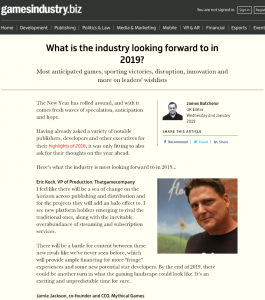
Welcome 12th cohort to Video Game Law at the Allard School of Law. One of the hallmarks of the course has been how rapidly the video game industry has evolved during that time, creating exponential complexity including legal complexity. As an introduction to what that looks like click on the article above to see some expert predictions for 2019…
Jon
Read More | No Comments
By Jon Festinger on January 13, 2019

In saying “au revoir” to this year’s cohort of students I mentioned something that my colleagues at the UBC Centre for Teaching, Learning & Technology have talked about alot over time – the feeling that boundaries around education are often artificial, and that the notion of scheduled classes within fixed semesters make little actual sense. Easy to say, harder to parse, and more difficult yet to do. But, as this website will attest, part of my December 30th was spent doing something seemingly a bit weird. I posted on several loose ends from the course – things I mentioned, argued or did. Was I posting too late for this cohort or too early for next one? Or can learning and teaching be communal and unboundaried, even if the formal study of a subject in law schools remains formally demarcated by the first day of class on one end and the posting of grades at the other. My answer is now clear, if only based on anecdotal evidence. From the ongoing interactions I’ve seen on course websites and webpages over the years, and the way former students find stay in touch with the course, it’s subject, each other (and occasionally with me), there is little doubt that we commit a profound deservice by time-stamping teaching and learning when we know that in law especially both are changing all the time.
That said, this post is the result, not the cause, of two related steps:
For the first time I have posted next years Syllabus on the website. It’s not much changed yet (other than dates) from this years. So often I have thought when reading something that it will alter the coming syllabus for the course and store it away to be revisited (or not). Odd then that it never occurred to me until now to simply put up a draft which can be played with in real time until we arrive at September 2019. Who knows it may even prompt past-student or colleagues to make suggestions knowing there can be evidence of change that happens nearly immediately. As for me I don’t have to remember where I filed the little morsel, or give up looking – assuming I even remember there was something I wanted to add.
The second step is the next post, my first directed to next year’s students – whoever they may be. Why not?
Jon
Read More | No Comments
By Jon Festinger on January 6, 2019

Posts on everything I remember promising to post – done. Papers marked. Marks up. A few extra emails done. Out of excuses for delaying this post.
You have been an extraordinary class. It was just so much fun…I really owe a lot to all of you. There are many reasons for how I feel, but a couple of them really stand out:
- Said a version of this in the last class, but it bears repeating. The 2018 version of Law 423C was very special IMHO precisely because of the number of international students and the involvement and commitment those students brought. When I wrote my original text on Video Game Law in 2005, it was really written without borders because the number of Canadian video game cases could be counted on the fingers of one hand. So I’ve always seen the subject as internationally rooted, and games themselves as making the world a smaller place. This academic semester just felt so congruent with those perspectives, that it almost felt like a kind of homecoming.
- There was always feedback and engagement from you – and lots of it. Whether through emails, posts, in-class, before or after class, there was always something to talk about. From the latest strange game-world event to whatever puzzled you most, it sometimes felt like we were dealing with as much outside of our scheduled times as within them. Have always felt that boundaries around education are artificial, and that the notion of scheduled classes within fixed semesters make little actual sense. Our interactions seems reinforcing of that.
- Speaking of which, over the summer we plan to migrate this website to a more advanced platform developed by UBC CTLT. That platform creates greater potential for ongoing community building, so expect to hear more about those possibilities and feel free to participate if you want to.
- Am still confused that we ended up with more students in our class after I (very clearly) explained that the way our law school’s rules work marks would be on average three marks lower unless registration went down by a fair number. Students who place learning above marks is every teachers dream, so count me as impressed…
- A huge thank you to those of you who used and provided feedback on the “Self-Socratic” tool that UBC CTLT and I created. Your support gives us the conviction that there is real potential here. We have lots to do over the next few months to implement versions 1.5 & 2.0. Hopefully some of you will want to test those versions and provide additional feedback.
So that’s it for me…for now. Thank you so much for everything you brought to Video Game Law. It was a lot. Please stay in touch.
Jon
Read More | No Comments
By Jon Festinger on December 30, 2018

The above is the only avatar I’ve ever used out of its game-given context. It was generated on an X-Box 360. An article on some (gaming?) website showed me how to export it, and so I did. It is slimmer and more jaundiced looking than I actually am (or was at time). The blue shirt is pretty accurate although the minimal resolution doesn’t allow for whether it’s buttoned down (as mine are) or not. Let’s not even start in on the virtual hair and how much more the avatar has then is my current reality. Hair colour and the process of greying should also be beyond discussion.
The question of whether avatars can be defamed comes up periodically (See, for example, Defamation of Second Life Avatars: How the Laws of First Life People Could Be Invoked). Today I just want to set out a few possible first principles for further analysis. I will use Canadian law as my jumping off point simply because one of previous lives as newsroom lawyer acquainted me with some of the principles to be applied and the cases that apply them. Some of the discussion that follows first manifested (if memory serves) during an improvised reply to a question during the semester.
So here goes…
- As the post just below this one illustrates my starting point is that there is no virtual world. What we call the virtual world is just part of this world and is subject to our worlds laws’, ethics, principles, and sense of justice. That digital issues have contextual differences that must be considered when applying our rules seems pretty obvious, though the devil will always be in the details.
- Accordingly, in principle there should be no problem defaming an avatar as long as the legal requirements of the tort are met.
- One particular aspect of defamation law makes it that much easier to see that defaming an avatar should have consequences. That aspect is the emphasis defamation law has always placed on “reputation” and it’s public manifestations. In fact some of the largest defamation awards in Canada have been attributable not to the private persona of the individual defamed, but to their public participation, persona, and stature. For example Vogel v. CBC (1982), 35 B.C.L.R. 7 (S.C.) was for many years understood to be the largest defamation award in B.C. (if not Canada), precisely because it involved the Richard Vogel, who at the time was Deputy Attorney-General of the Province. The case of Hill v. Church of Scientology of Toronto (Supreme Court of Canada) similarly involved a recognizable crown prosecutor.
- In this context, what is an avatar other than part of one’s public persona? In an ontological sense there is no difference between a game avatar and being Deputy AG or Crown Counsel. All are personas projected from a real-life person that occupy a public-facing space. All have qualifications to entry and public privileges associated with the exercise of their public persona and position.
- There remain some difficult questions. Perhaps the most challenging is what should be done in respect of an avatar of huge reputation whose human originator is masked or unknown. My first instinct is that as long as the person behind the avatar is ascertainable and exists, the relative proportion of public to private reputation should not be a factor, and is not in the cases as I read them. That said I don’t believe an A.I. (Artificial Intelligence) can sue, since Defamation is very much rooted in the “sting” to our egos we humans feel when personally attacked. But who knows, if machines ever are acknowledged as sufficiently conscious, this too could change.
Hopefully this has been a useful conceptual introduction. Would appreciate any feedback or questions.
Jon
Read More | No Comments
By Jon Festinger on December 30, 2018
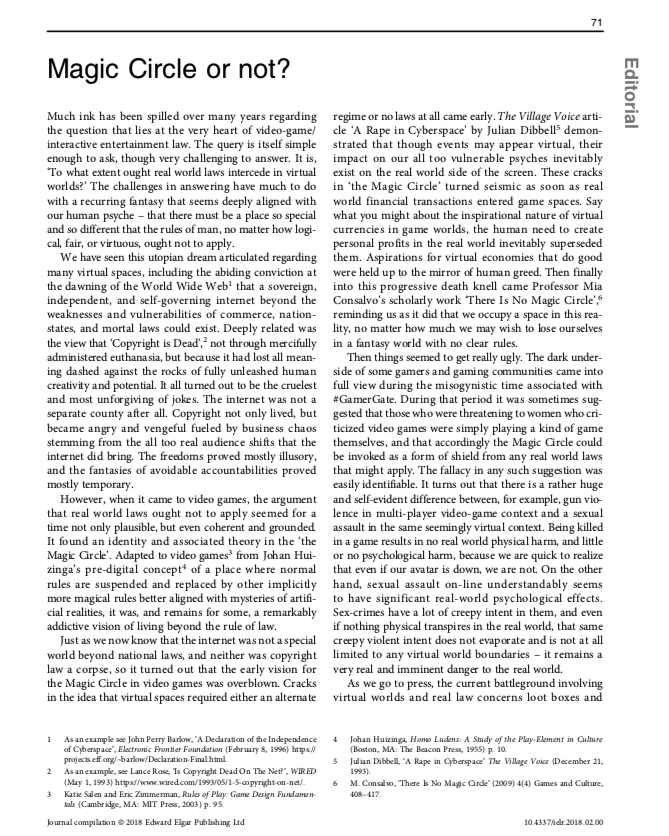
In the second issue of the first volume of the Interactive Entertainment Law Review you will find the editorial (linked to through the above screencap) titled “Magic Circle or not?”. The material therein was essentially worked through with the help of the class during the past semester as can be evidenced through bits and pieces locatable in various of this semesters’ PowerPoints and Videos. The bottom line is (and this is hardly a new argument – credit Professor Mia Consolvo with the most articulate and original version) that the Magic Circle is not something we should treat as real, because it never was nor will be. There is no digital world, only the real world with the digital aspects and manifestations within it. That, of course, does not mean that everything that manifests digitally should be treated by law as the equivalent of the event depicted. The murder of a digital avatar in a game is decidedly not a real world murder for legal purposes, but nor is it automatically and necessarily an event without meaning or consequence. So much must depend on context and real-world impacts, as the example of sexual assault in the Editorial should illustrate.
The point being that if we simply accept what is obviously true, that the digital world we surf and play in, is just part of the real world, it becomes substantially easier to calibrate the appropriateness (or not) of legal interventions. The so-called “Magic Circle” was never IMHO a description of an alternate universe but rather an explanation for differential rule-making within our own.
The next post on “Defaming Avatars” digs a bit deeper into what all this looks like when applied….
Jon
Read More | No Comments
By Jon Festinger on December 30, 2018
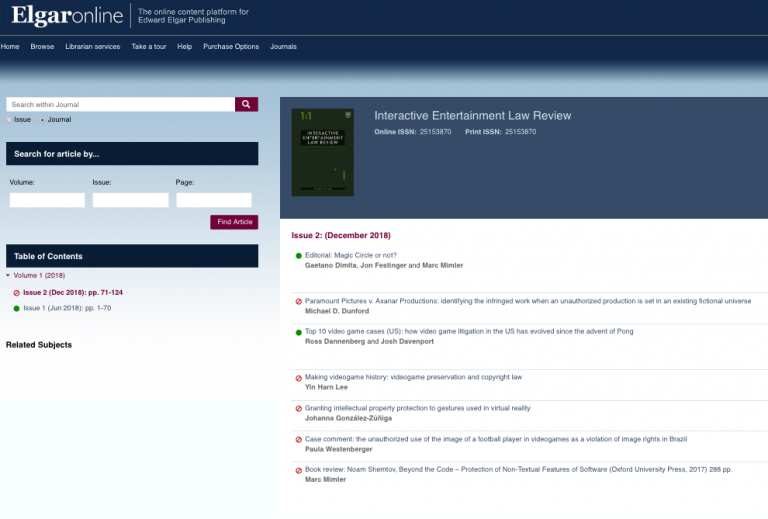
The second issue of the first volume of the Interactive Entertainment Law Review is out. Click on the screencap above to access the webpage. Aside from the Editorial (more on that in the next post), there is a free to download piece titled “Top 10 video game cases (US): how video game litigation in the US has evolved since the advent of Pong” by Ross Dannenberg and Josh Davenport that is well worth reading.
Jon
Read More | No Comments
By Jon Festinger on December 30, 2018
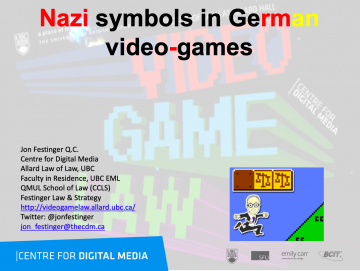
The above set of slides are at least in part fictional. They are an attempt to recreate post-facto the comments I made as part of a panel titled “Youth protection, censorship & culture: is anything possible in computer games now?” at “More Than Just A Game | Frankfurt”.
Jon
Read More | No Comments
By Jon Festinger on December 30, 2018

On October 21 I posted about “More Than Just a Game/Frankfurt which I had just returned from. Within that post were the slides I presented on “Streaming (video-game) boxes” and their legal trajectories. Attached above is a summary from the law firm of Beiten Burkhardt of the event, the topics presented, and some interesting real time polling results.
Jon
Read More | No Comments







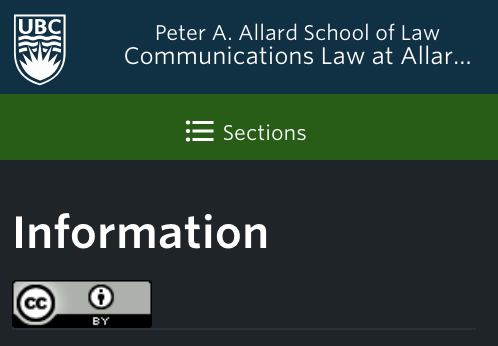 Communications Law
Communications Law